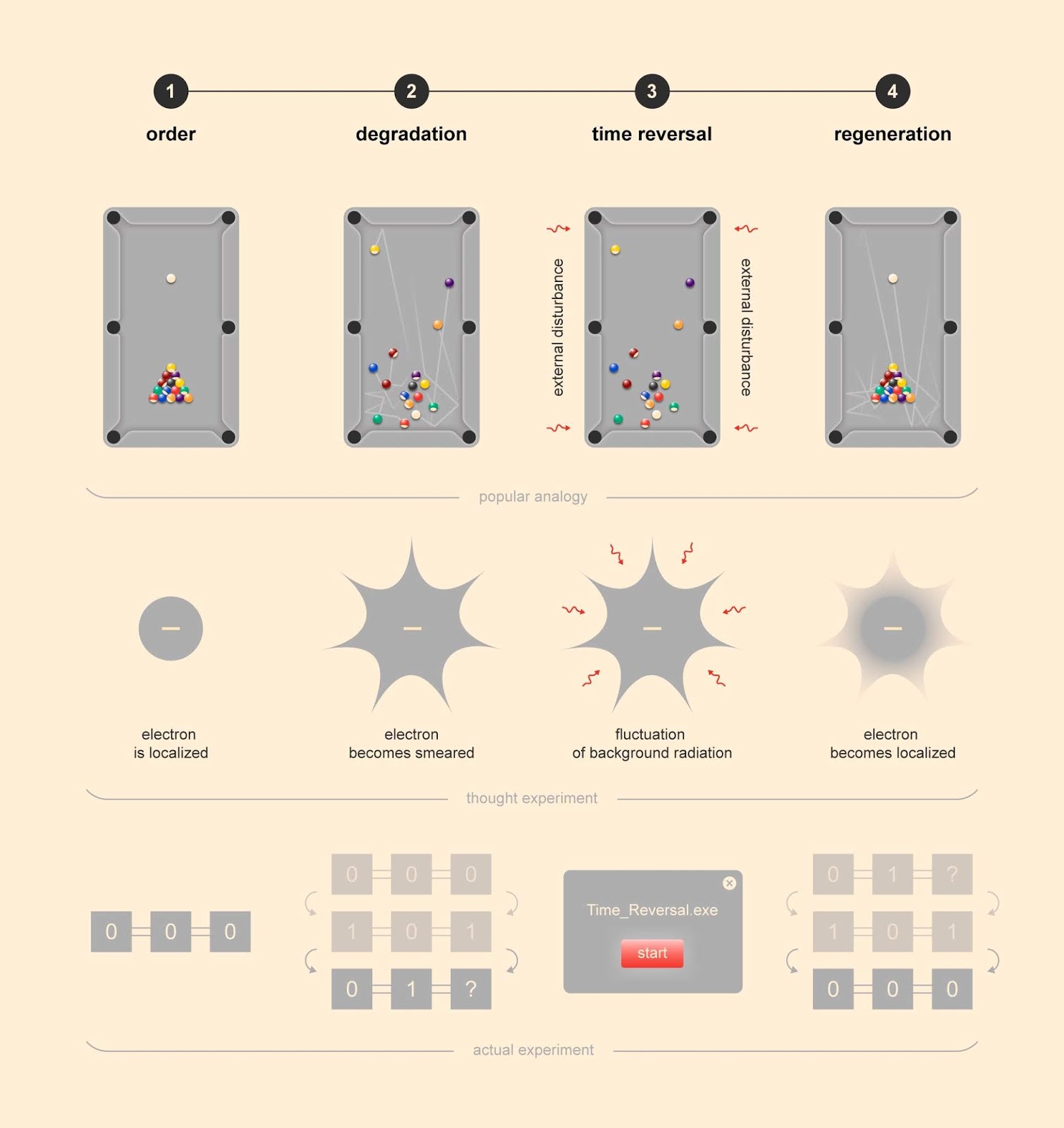
@tsarcyanide/MIPT
Researchers from the Moscow Institute of Physics and Technology worked with colleagues from the United States and Switzerland and returned the state of a quantum computer a fraction of a second into the past. Moreover, they calculated the probability that an electron in empty interstellar space will spontaneously travel back into its recent past. Their study is published in Scientific Reports.
Most laws of physics do not make any distinction between the future and the past. For instance, let an equation describe the collision and rebound of two identical billiard balls. If a close-up of this event is recorded with a camera and played in reverse, it can still be represented by the same equation. Furthermore, it isn't possible to distinguish from the recording if it has been doctored. Both versions look plausible. It'd appear that the billiard balls defy the intuitive sense of time.
Nevertheless, imagine recording a cue ball breaking the pyramid, the billiard balls scattering in all directions. In this case, it's easy to distinguish the real-life scenario from reverse playback. Our intuitive understanding of the second law of thermodynamics—an isolated system either stays static or evolves toward a state of chaos rather than order - is what makes reverse playback look so absurd.
Most other laws of physics don't prevent rolling billiard balls from assembling into a pyramid, infused tea from flowing back into the tea bag, or a volcano from "erupting" in reverse. However, these phenomena aren't observed, because they would require an isolated system to assume a more ordered state without any outside intervention, that runs contrary to the second law. The nature of this law hasn't been explained in full detail, but researchers have made great headway in understanding the basic principles behind it.
Quantum physicists from MIPT decided to check if time could spontaneously reverse itself at least for an individual particle and for a tiny fraction of a second. This means that rather than colliding billiard balls, they examined a solitary electron in empty interstellar space.

The four stages of the actual experiment on a quantum computer mirror the stages of the thought experiment involving an electron in space and the imaginary analogy with billiard balls. Each of the three systems initially evolves from order toward chaos, but then a perfectly timed external disturbance reverses this process. Credit: @tsarcyanide/MIPT
Study co-author Andrey Lebedev from MIPT and ETH Zurich explained that the evolution of the electron state is governed by Schrödinger's equation. Even though it makes no distinction between the future and the past, the region of space containing the electron will spread out very quickly. This means, the system become more chaotic. The uncertainty of the electron's position is growing. That's analogous to the increasing disorder in a large-scale system because of to the second law of thermodynamics.
Then, the researchers tried to reverse time in a four-stage experiment. They observed the state of a quantum computer made of two and then three basic elements called superconducting qubits.
"Stage 1: Order. Each qubit is initialized in the ground state, denoted as zero. This highly ordered configuration corresponds to an electron localized in a small region, or a rack of billiard balls before the break.
Stage 2: Degradation. The order is lost. Just like the electron is smeared out over an increasingly large region of space, or the rack is broken on the pool table, the state of the qubits becomes an ever more complex changing pattern of zeros and ones. This is achieved by briefly launching the evolution program on the quantum computer. Actually, a similar degradation would occur by itself due to interactions with the environment. However, the controlled program of autonomous evolution will enable the last stage of the experiment.
Stage 3: Time reversal. A special program modifies the state of the quantum computer in such a way that it would then evolve "backwards," from chaos toward order. This operation is akin to the random microwave background fluctuation in the case of the electron, but this time, it is deliberately induced. An obviously far-fetched analogy for the billiards example would be someone giving the table a perfectly calculated kick.
Stage 4: Regeneration. The evolution program from the second stage is launched again. Provided that the "kick" has been delivered successfully, the program does not result in more chaos but rather rewinds the state of the qubits back into the past, the way a smeared electron would be localized or the billiard balls would retrace their trajectories in reverse playback, eventually forming a triangle."
The researchers discovered that in 85% of the cases, the two-qubit quantum computer returned back into the initial state. When three qubits were involved, more errors happened, leading to a roughly 50% success rate. As the authors reported, those errors are due to imperfections in the actual quantum computer. As more sophisticated devices are designed, the error rate is expected to drop.
Intriguingly, the time reversal algorithm itself could prove useful for making quantum computers more precise.
References: Scientific Reports, Moscow Institute of Physics and Technology, Phys.org












Their study is published in Scientific Reports. ADM-201 exam dumps
ReplyDelete